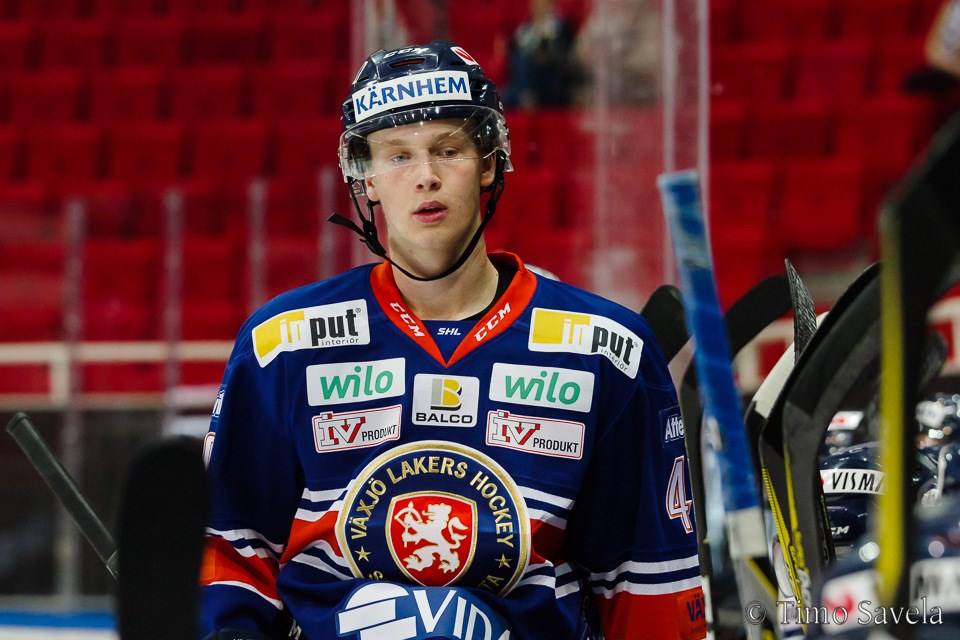All due respect to Olli Juolevi and Thatcher Demko, but Elias Pettersson is the Canucks’ most important prospect. He represents their only shot at a first-line centre currently in the system.
The only other notable centre in the prospect pool is Adam Gaudette; after him, their centre depth gets shallower than a kiddie pool in a drought. There’s Brett McKenzie, Dmitriy Zhukenov, Zack MacEwen, Griffen Molino, and, if you’re feeling charitable, Cole Cassels. Other than Gaudette, none of those centres have potential top-six upside and a top-six projection is even a little optimistic for Gaudette.
Fortunately, Pettersson looks to be developing exactly as the Canucks had hoped he would in the Swedish Hockey League this season.
It’s early yet, but Pettersson is off to a great start, putting up 7 points, all assists, in 8 games. That leads all under-20 players in scoring in the SHL and is tied for second in scoring on the Lakers. On top of that, he’s tied for the team-lead in scoring in the Champion’s Hockey League with 2 goals and 5 points in 5 games.
That gives him a total of 12 points in 13 games with the Lakers, though the competition is a little less steep in the Champion’s League.
There is an issue of sample size, of course. If we had looked in on Pettersson a few games ago, he would have had 3 points in 6 games, which looks a little less impressive than 7 in 8. A few games before that and we would see 3 points in 3 games — a point-per-game pace! So it’s important to temper expectations a little bit.
With that in mind, let’s try to define what reasonable expectations should be for Pettersson. What would constitute a good season?
Looking at the players that have led the SHL in scoring the past several years brings up Carl Grundstrom, Oskar Lindblom, Jakub Vrana, and Andreas Johnsson. None of those players scored more than 25 points across 44+ games.
Of those four players, Vrana is the most interesting comparable for Pettersson. The Capitals selected Vrana 13th overall in 2014 and he put up 12 goals and 24 points in 44 SHL games in the year after he was drafted. He then spent parts of two seasons in the AHL and is now skating on the Capitals’ first line alongside Alex Ovechkin and Evgeny Kuznetzov at the age of 21, with 5 points in 7 games.
That would be a decent path to the NHL for Pettersson to follow — NHL debut at 20, first line at 21 — but Pettersson is on-pace to obliterate Vrana’s draft+1 numbers.
Let’s expand beyond that small group of players to see how Pettersson’s season is shaping up compared to past under-20 players in the SHL.
Keep in mind, these are the best under-20 seasons in the SHL over the last six years. If Pettersson can keep up this pace — and it’s a pretty big if — then his closest comparable will be William Nylander.
Nylander split his post-draft 2014-15 season between the SHL and AHL, tallying impressive numbers in both. He had 20 points in 21 SHL games and 32 points in 37 AHL games to go with 10 points in 7 games for Team Sweden at the World Juniors. He made his NHL debut the following season at 19, with 13 points in 22 games, then made the NHL full-time last season, putting up 22 goals and 61 points in 81 games on the Leafs’ first line with Auston Matthews and Zach Hyman.
There are a couple things to consider here: one is that Nylander was heavily leaned on by MODO in his 21 games, averaging over 19 minutes per game. Pettersson, on the other hand, is averaging just over 14 minutes per game. We’ll see if that increases as the season progresses.
The other is that Nylander took a lot more shots than Pettersson. Nylander averaged 1.95 shots per game in 2014-15, while Pettersson is averaging just 1.5 shots per game. He has yet to score a goal in regular season action in the SHL; directing a few more shots towards the net would help.
Comparing Pettersson to Nylander is a little unfair: Nylander legitimately had one of the greatest draft+1 seasons in SHL history. For a little more reason and some fancier stats, I turn to Jeremy Davis of Canucks Army.
Davis estimates that a reasonable expectation for Pettersson this season would be 0.52 points per game. That puts him in the same range as Vrana, Lindblom, and Mika Zibanejad from past SHL seasons and would project to around 25 points. So far, Pettersson is outdoing those reasonable expectations.
So, how about some completely unreasonable expectations? Daniel and Henrik Sedin both played for MODO in the Swedish Elite League in the year after they were drafted. Daniel put up 45 points in 50 games, while Henrik put up 47 points in 50 games. It’s optimistic, but not out of the question to think that Pettersson might match those numbers this season.
Considering how much the Canucks need Pettersson to become not just a good NHLer, but a franchise forward, that’s exactly what the Canucks are hoping to see.



